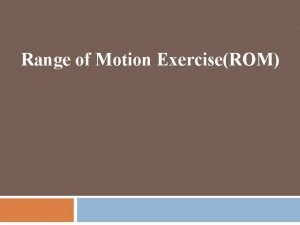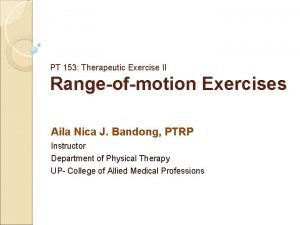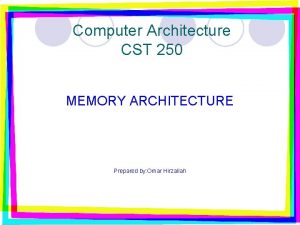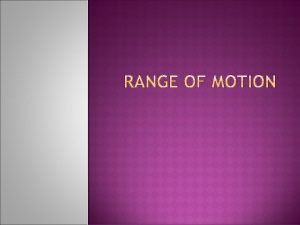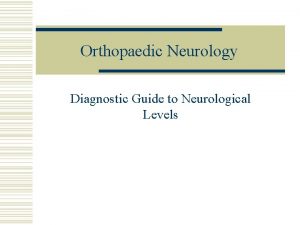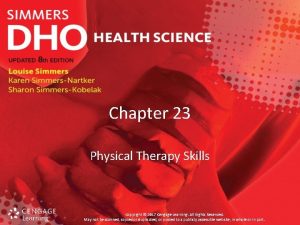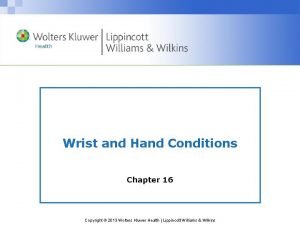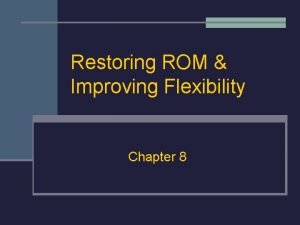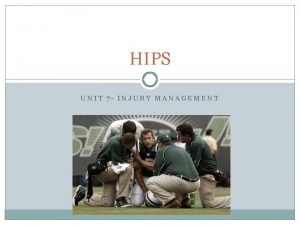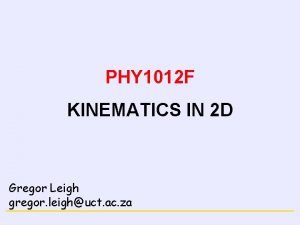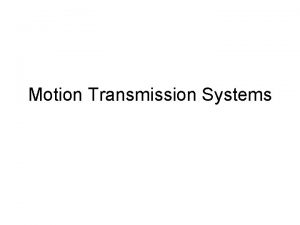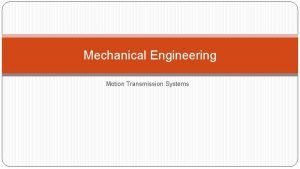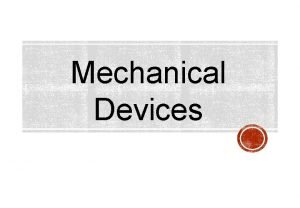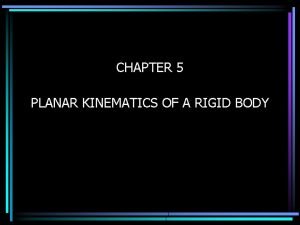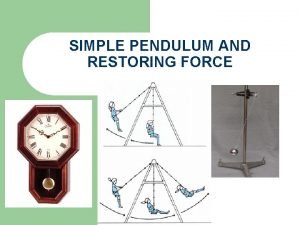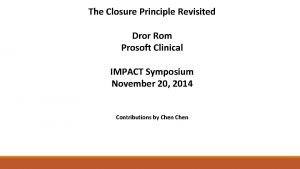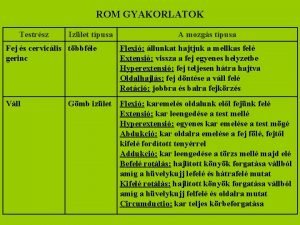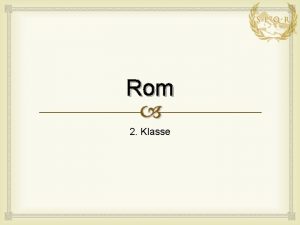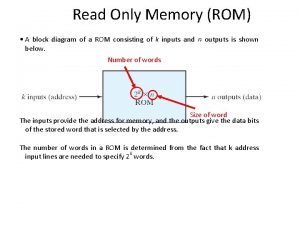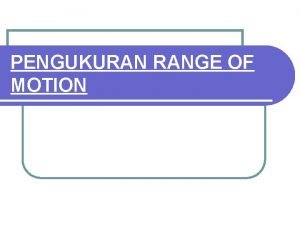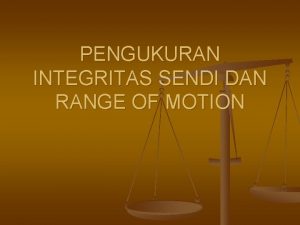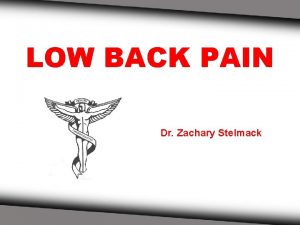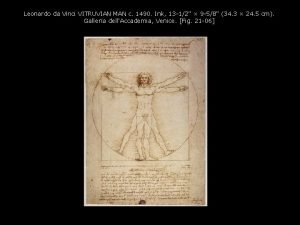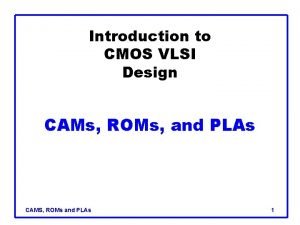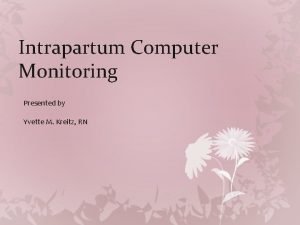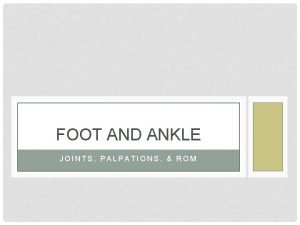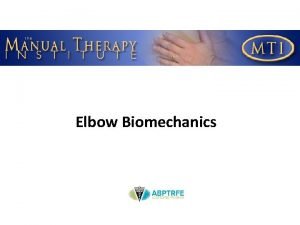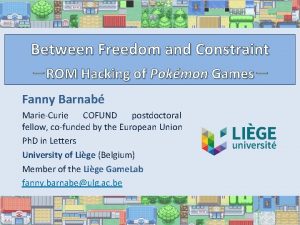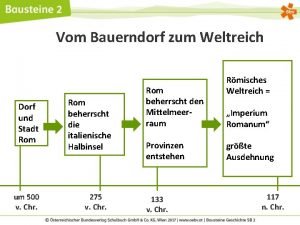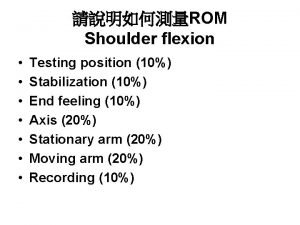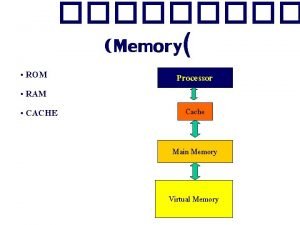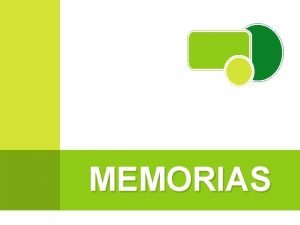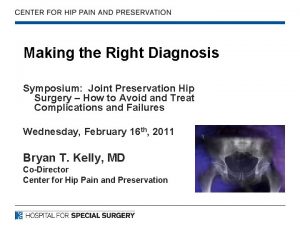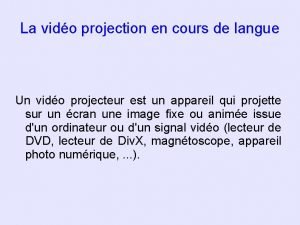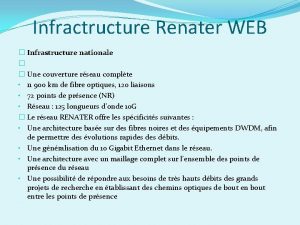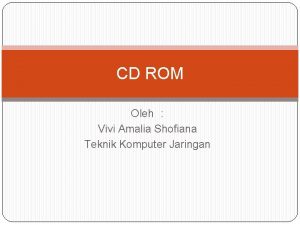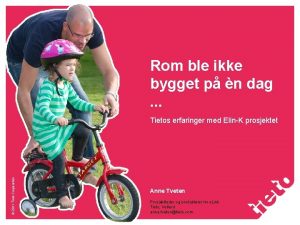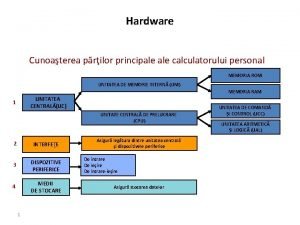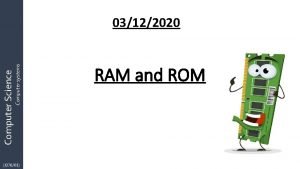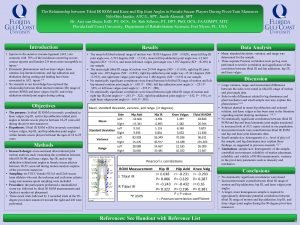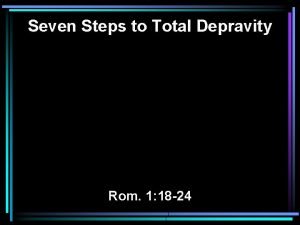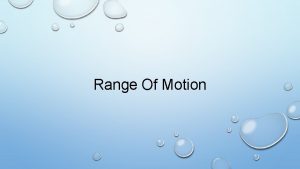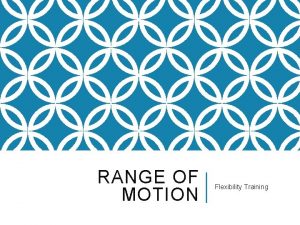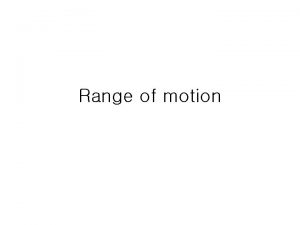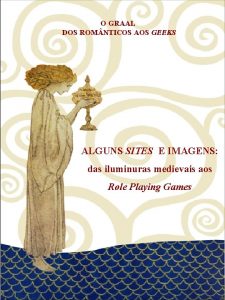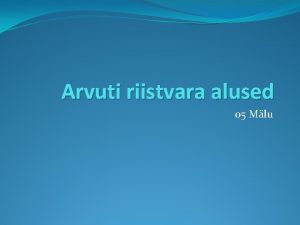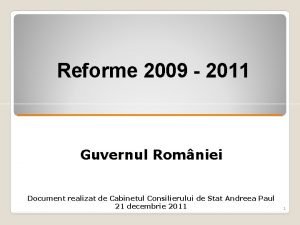RANGE OF MOTION ROM Types of range of









































































- Slides: 73

RANGE OF MOTION - ROM • Types of range of motion: – Active - resident exercises joints without help – Passive - another person moves body part for resident 4. 02 Nursing Fundamentals 7243 1

• Purpose of range of motion: – Maintains muscle tone – Prevents deformities – Increases circulation – Encourages mobility 4. 02 Nursing Fundamentals 7243 2

ROM - GUIDELINES • Expose only part of body being exercised • Be gentle and STOP if resident complains of PAIN • Use good body mechanics 4. 02 Nursing Fundamentals 7243 3

• Follow directions from supervisor on number of times each joint to be exercised and how to perform exercises safely, based on each resident’s condition 4. 02 Nursing Fundamentals 7243 4

• Each movement is repeated three times unless otherwise ordered. • Support joint as it is exercised • Report complaints of pain or discomfort to supervisor 4. 02 Nursing Fundamentals 7243 5

• Exercise joint slowly, smoothly and gently • Do not exercise swollen, reddened joints; report condition to supervisor 4. 02 Nursing Fundamentals 7243 6

• • 4. 02 Abduction Adduction Extension Hyperextension Flexion Plantar flexion Dorsiflexion Rotation Nursing Fundamentals 7243 7

• Pronation • Supination • Eversion • Inversion • Radial deviation • Ulnar deviation 4. 02 Encourage residents capable of doing active ROM exercises Nursing Fundamentals 7243 8

Training Lab Assignment Engage in the Skill Acquisition Process for: SKILL 4. 02 C Range of Motion 4. 02 Nursing Fundamentals 7243 9

Restorative/Rehabilitative Care PROSTHETIC DEVICES 4. 02 Nursing Fundamentals 7243 10

PROSTHETIC DEVICES • Artificial Eye (glass eye) – encourage resident to remove, clean and replace eye prosthesis if able 4. 02 Nursing Fundamentals 7243 11

• Eyeglasses – Lens made of glass or plastic – *Stored in protective case to prevent damage when not in use – Held by frames 4. 02 Nursing Fundamentals 7243 12

• Eyeglasses (continued) – Washed under running water using mild detergent. • rinsed with clear water • dried with tissue or soft cloth 4. 02 Nursing Fundamentals 7243 13

• Eyeglasses… – Tops of ears and nose observed for redness or irritation from glasses • Wash hands before and after cleansing resident’s glasses 4. 02 Nursing Fundamentals 7243 14

• Contact Lenses (hard or soft) – Resident encouraged to care for lenses 4. 02 Nursing Fundamentals 7243 15

• Contact Lenses (hard or soft) Unusual observations to be reported: • redness • itching • swelling • complaints of pain, blurring, or scratching sensations 4. 02 Nursing Fundamentals 7243 16

• Hearing Aid – Ear piece cleaned daily with soap and water; this is the only washable part – Ear piece and tubing should be soft – Wax cleaned from tubing with special equipment 4. 02 Nursing Fundamentals 7243 17

• Hearing Aid… • Batteries checked for power – Skin observed for redness or irritation in or around ear – Ear wax build-up reported to supervisor 4. 02 Nursing Fundamentals 7243 18

• Inserting hearing aid: – turn volume toward maximum until whistle is heard – replace batteries if whistle cannot be heard – turn volume to low setting 4. 02 Nursing Fundamentals 7243 19

• Inserting hearing aid (continued): – gently insert ear piece into ear canal and adjust for comfort – loop over ear for over-the-ear models – adjust volume to resident’s satisfaction 4. 02 Nursing Fundamentals 7243 20

• Removing hearing aid: – turn volume to lowest level or off – *gently lift ear piece up and out of ear – use tissues to wipe wax off ear piece – store in safe place – remove battery when not in use or open battery case 4. 02 Nursing Fundamentals 7243 21

• Braces – Uses • support a weak part of the body • prevent movement of joint • correct deformities • prevent deformities 4. 02 Nursing Fundamentals 7243 22

• Braces (continued) – *Materials • metal leather plastic – Bony parts under brace require protection in order to prevent skin irritation – Report any wear noticed and when brace parts are loose or missing 4. 02 Nursing Fundamentals 7243 23

• Braces (continued) – Shoes custom fitted and checked for: • broken shoe laces • heels and soles that are worn • leather that is worn or torn • damage from perspiration – odors – stains 4. 02 Nursing Fundamentals 7243 24

• Devices for use with amputation – Definition of amputation - partial or complete removal of a body part • usually arm or leg • below knee most common amputation 4. 02 Nursing Fundamentals 7243 25

• Devices for use with amputation (continued) – *Examples of prosthetic devices: • artificial leg • artificial foot • artificial arm • artificial hand 4. 02 Nursing Fundamentals 7243 26

• Devices for use with amputation (continued) – Prosthesis fitted and made for each individual. – Devices must be handled with care and stored in appropriate place when not in use. 4. 02 Nursing Fundamentals 7243 27

Assisting with artificial limbs: – have right device – check all parts for damage – evaluate resident’s limb for irritation and swelling – pad area of prosthesis touching resident 4. 02 Nursing Fundamentals 7243 28

Assisting with artificial limbs (continued): – clean according to individual instructions – report any needed repairs to supervisor – observe and report any skin changes to supervisor 4. 02 Nursing Fundamentals 7243 29

• Breast Forms – used following removal of breast – Assist female residents with adjustments of forms when dressing – Follow care suggested by manufacturer – Keep form separate and in safe place when handling clothing for laundry – *Do not put in laundry 4. 02 Nursing Fundamentals 7243 30

Restorative/Rehabilitative Care MOBILITY NEEDS 4. 02 Nursing Fundamentals 7243 31

BODY MECHANICS FOR RESIDENTS • Broad base of support leads to better balance and stability • Keep weight the same on both feet • Stoop using the hips and knees 4. 02 Nursing Fundamentals 7243 32

• Keep the back straight • Lift and carry objects close to body for better balance. • Use both hands to lift or move objects • Use smooth, even movements 4. 02 Nursing Fundamentals 7243 33

• Do not bend or reach if injury possible; ask for help • Do not twist body to reach an object • Keep body in good alignment 4. 02 Nursing Fundamentals 7243 34

DANGLING • Dangling - sitting on edge of bed before getting up – Standing up too quickly may cause feeling of dizziness and fainting may occur 4. 02 Nursing Fundamentals 7243 35

• *Dangling for several minutes allows resident to progress to standing and walking without feeling faint • Taking deep breaths helps to prevent light-headedness 4. 02 Nursing Fundamentals 7243 36

• Most common signs/symptoms if feeling faint: – pale face – complaints of dizziness or weakness 4. 02 Nursing Fundamentals 7243 37

• Return resident to supine position if they have difficulty dangling • If dangling is well tolerated, progress to standing position 4. 02 Nursing Fundamentals 7243 38

STANDING • Get assistance if resident is weak or unsteady • *Assist resident to stand by placing your hands under the resident’s arms with hands around the shoulder blades, and use good body mechanics to assist to standing position 4. 02 Nursing Fundamentals 7243 39

• Have resident stand by side of bed for several minutes prior to ambulating • Return to bed or assist to chair if having difficulty standing • If standing tolerated, progress to ambulating 4. 02 Nursing Fundamentals 7243 40

AMBULATING – WALKING • *Effects on body – stimulates circulation – strengthens muscles – relieves pressure on body parts – increases joint mobility – improves function of digestive and urinary systems 4. 02 Nursing Fundamentals 7243 41

• Effects on body (continued) – increased independence leads to more positive selfimage – provides sense of accomplishment – prevents lung congestion 4. 02 Nursing Fundamentals 7243 42

• Encourage to ambulate as much as possible • Suggest use of handrails for support 4. 02 Nursing Fundamentals 7243 43

• If resident starts to fall, ease to the floor by: – grasping gait belt – resting buttocks against nurse aide’s leg – sliding down aide’s leg to floor 4. 02 Nursing Fundamentals 7243 44

• Be prepared to assist, but allow the resident to do as much as possible • Safety considerations: – use gait belt – get assistance if needed – allow adequate time for walking so resident does not feel rushed 4. 02 Nursing Fundamentals 7243 45

Training Lab Assignment Engage in the Skill Acquisition Process for: SKILL 4. 02 D DANGLE, STAND, WALK 4. 02 Nursing Fundamentals 7243 46

Training Lab Assignment Engage in the Skill Acquisition Process for: SKILL 4. 02 E TRANSFER BED TO WHEELCHAIR (CHAIR) 4. 02 Nursing Fundamentals 7243 47

Training Lab Assignment Engage in the Skill Acquisition Process for: SKILL 4. 02 F TRANSFER BED TO STRETCHER 4. 02 Nursing Fundamentals 7243 48

Restorative/Rehabilitative Care CAST CARE 4. 02 Nursing Fundamentals 7243 49

CAST CARE • *Cast used to immobilize body part, providing time for part to heal 4. 02 Nursing Fundamentals 7243 50

• Cast materials – *Plaster of Paris • 24 -48 hours to dry • expands and gives off heat while drying…heavy – Fiberglass • dries rapidly • lighter than plaster casts – Plastic 4. 02 Nursing Fundamentals 7243 51

• *Care of Casts – Allow to air dry – Keep cast uncovered – Use pillows to support cast – Support cast with palms of hands 4. 02 Nursing Fundamentals 7243 52

• Care of Casts – Never put pressure on cast – Turn and position frequently to allow air to circulate around cast 4. 02 Nursing Fundamentals 7243 53

• Maintain good body alignment • Keep cast dry • Observe cast for rough edges and report • Over-bed trapeze provided if appropriate 4. 02 Nursing Fundamentals 7243 54

• Vomiting • Elevated temperature • Skin irritation around edge of cast 4. 02 Nursing Fundamentals 7243 55

• Drainage • Odors • Swelling of fingers or toes, inability to move parts • Change in color of skin: paleness, cyanosis 4. 02 Nursing Fundamentals 7243 56

• Resident with cast reports of: Pain Numbness Tingling sensations – Chills – Hot or cold skin – – – 4. 02 – Itching – Tightness – Inability to move fingers or toes – Nausea Nursing Fundamentals 7243 57

COUGHING AND DEEP BREATHING 4. 02 Nursing Fundamentals 7243 58

COUGHING AND DEEP BREATHING • Purposes – To prevent respiratory complications in certain at-risk residents • persons on bed rest or reduced activity • following surgery • person with respiratory disorders 4. 02 Nursing Fundamentals 7243 59

• Purposes – *Two major complications prevented by coughing and deep breathing: • pneumonia - inflammation of lung • atelectasis - collapse of portion of lung 4. 02 Nursing Fundamentals 7243 60

• Physiology – Deep Breathing • increases level of oxygen in blood • increases lung expansion 4. 02 Nursing Fundamentals 7243 61

• Physiology – *Coughing • removes mucus from airways and lungs • may cause collapse of lung if congestion not present 4. 02 Nursing Fundamentals 7243 62

• Considerations with deep breathing and coughing – Doctors order exercises – Frequency of performing exercise varies per doctor’s order 4. 02 Nursing Fundamentals 7243 63

• Considerations with deep breathing and coughing – Nurse aides receive instructions from supervisor – Coughing may cause pain and be difficult to perform 4. 02 Nursing Fundamentals 7243 64

Training Lab Assignment Engage in the Skill Acquisition Process for: SKILL 4. 02 G COUGH AND DEEP BREATH 4. 02 Nursing Fundamentals 7243 65

ANTI-EMBOLIC STOCKINGS/HOSE 4. 02 Nursing Fundamentals 7243 66

ANTI-EMBOLITIC STOCKINGS/HOSE • Purpose – Provide support – Provide comfort – Promote circulation by providing pressure – Reduce risk of thrombus formation 4. 02 Nursing Fundamentals 7243 67

• *Indications for use – Residents with heart disease and circulatory disorders – Residents on bed rest – Residents who recently had surgery 4. 02 Nursing Fundamentals 7243 68

• Prevention of blood clots (thrombi) – blood clots form (blood flow is sluggish) – usually develop in deep leg veins – can break loose and travel though blood stream (then known as embolus) 4. 02 Nursing Fundamentals 7243 69

• Prevention of blood clots (thrombi) – embolus can travel to the lungs and possibly cause death – elastic stockings exert pressure on veins, promoting venous blood flow to heart – also known as anti-embolitic stockings or TED hose 4. 02 Nursing Fundamentals 7243 70

• Fitting of stockings – Come in thigh or knee high lengths – Resident must be measured to ensure proper fit 4. 02 Nursing Fundamentals 7243 71

Training Lab Assignment Engage in the Skill Acquisition Process for: SKILL 4. 02 H ANTI-EMBOLITIC STOCKING 4. 02 Nursing Fundamentals 7243 72

END 4. 02 Understand nurse aide’s range of function in rehabilitative/restorative and maintenance care. 4. 02 Nursing Fundamentals 7243 73
 Active assistance rom
Active assistance rom Passive and active rom
Passive and active rom Range of motion
Range of motion Active and passive range of motion
Active and passive range of motion Goniometer wrist
Goniometer wrist Types of rom memory
Types of rom memory Simple harmonic motion formula
Simple harmonic motion formula An object in motion stays in motion
An object in motion stays in motion Chapter 2 section 1 describing motion answer key
Chapter 2 section 1 describing motion answer key Describing and measuring motion
Describing and measuring motion Motion section 1 describing motion
Motion section 1 describing motion Concept 1 notes describing motion
Concept 1 notes describing motion Motion section 1 describing motion
Motion section 1 describing motion Range of motion definition
Range of motion definition Elbow range of motion
Elbow range of motion Extension lag
Extension lag Chapter 23:1 performing range of motion exercises
Chapter 23:1 performing range of motion exercises Kiloh nevin sign
Kiloh nevin sign Range of motion active and passive
Range of motion active and passive Range of motion active and passive
Range of motion active and passive Range of motion exercise
Range of motion exercise Range motion
Range motion As compared to long-range forecasts, short-range forecasts
As compared to long-range forecasts, short-range forecasts Motion transmission examples
Motion transmission examples Types of motion transmission systems
Types of motion transmission systems How many types of motion are there in mechanical devices
How many types of motion are there in mechanical devices Types of motion with examples
Types of motion with examples What is mean by periodic motion
What is mean by periodic motion Prosoft clinical
Prosoft clinical Hacking tamagotchi
Hacking tamagotchi Rom gyakorlatok
Rom gyakorlatok Hdd bus
Hdd bus Sage rom
Sage rom Read only memory rom diagram
Read only memory rom diagram Cây rơm đã cao và tròn nóc
Cây rơm đã cao và tròn nóc Abnormal end feel
Abnormal end feel Soft end feel adalah
Soft end feel adalah Usb rom adalah
Usb rom adalah Back hurts
Back hurts Michelangelo pieta rom
Michelangelo pieta rom Vlsi
Vlsi Hill rom watchchild
Hill rom watchchild Toe rom
Toe rom Radioulnar proximal
Radioulnar proximal Pokemon my ass rom
Pokemon my ass rom Sejarah tingkatan 1 tamadun rom
Sejarah tingkatan 1 tamadun rom Vom bauerndorf zum weltreich
Vom bauerndorf zum weltreich Rom shoulder flexion
Rom shoulder flexion Estilo gótico em portugal
Estilo gótico em portugal Cache rom
Cache rom Rom internal structure
Rom internal structure Memoria rom
Memoria rom Hip rom
Hip rom Un cd rom
Un cd rom Infractructure
Infractructure Fungsi dari dvd rom
Fungsi dari dvd rom Antikt plagg i rom
Antikt plagg i rom Hip abduction rom
Hip abduction rom Wihawk
Wihawk Leon rom
Leon rom Rom ble ikke bygget på en dag
Rom ble ikke bygget på en dag Duonos ir žaidimų posakis
Duonos ir žaidimų posakis Rom 8 28
Rom 8 28 Memorii rom
Memorii rom Spruch isar iller lech und inn
Spruch isar iller lech und inn Die reisen des apostel paulus
Die reisen des apostel paulus Is rom volatile or nonvolatile
Is rom volatile or nonvolatile Rom 11:36
Rom 11:36 Rom pynt
Rom pynt Ir rom
Ir rom Seal of truth rom
Seal of truth rom Roman 8:31-39
Roman 8:31-39 Faryion wardrip
Faryion wardrip Rom. 1:20
Rom. 1:20
